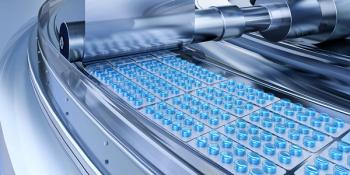
Sterile, Automated Sampling Enabling PAT for Biopharmaceutical Manufacturing
Pfizer, Eli Lilly, and several other pharmaceutical companies are participating in the development of automated sampling technology and associated software that improve process control and reduce development times in biopharmaceutical manufacturing.
Unlike in the chemical and food industries, and even in small-molecule pharmaceutical manufacturing, which have well-established methods for automated online sampling, the biopharmaceutical sector remains in need of a reliable system that transfers bioprocess samples directly from bioreactors to analytical devices while maintaining process sterility. Such a system is necessary if biopharmaceutical companies are to effectively take advantage of process analytical technology (PAT) and gain a more fundamental understanding of what is happening within bioreactors. While on-line Raman and dielectric spectroscopy provide some insight, there remains a need for integration of this data with off-line measurements, such as cell density, viability, metabolite levels, and titers.
To overcome this issue, Bend Research (recently acquired by Capsugel), in collaboration with major biopharmaceutical companies, including Pfizer, Eli Lilly, and Boehringer Ingelheim, has developed the Modular Automated Sampling Technology (MAST) platform, which consists of a sterile sampling system, a sample scheduler and navigator for automated sampling and delivery of samples to various analytical instruments, and a data-management system for collecting and analyzing the results, and if desired, providing feedback to the bioreactor for direct adjustment of reaction conditions.
Sterile sampling is now possible
The heart of the MAST platform is the new sterile sampling unit referred to as the Sample Pilot, which consists of a sampling module and an associated programmable logic controller (PLC). There are two Sample Pilot modules, the SP100, which collects 50-mL samples for monitoring of pilot- and commercial-scale manufacturing operations, and the SP200, which takes incremental 5-mL samples for analysis of development-scale reactions and reactions that run in smaller laboratory-scale bioreactors and pilot-scale, single-use bioreactors. Each sample assembly consists of proprietary valves and a pump and is designed to draw samples from the bioreactor and push them out to user-defined destinations, according to Clint Pepper, a director at Bend Research. “Because we use positive displacement, rather than pulling the samples out with a vacuum, it is possible to deliver even viscous culture samples with high cell densities to analytical instruments more than 50 feet away.”
Importantly, both systems can be sterilized in place (SIP), autoclave-sterilized, or gamma-sterilized depending on the model selected. “The entire system can be cleaned and sanitized between each sampling, and there is flexibility for users to adapt various cleaning procedures depending on their specific needs,” notes Lisa Graham, senior vice-president of Bend Research.
Sample and data management
To maximize the potential of sterile biopharmaceutical sampling, the MAST platform design includes software systems for managing sample scheduling, delivery of the samples, processing of the analytical results, and adjustment of bioreactor parameters if desired. “The MAST Sample Scheduler and Navigator modules will work together to facilitate sample collection from up to eight bioreactors, sending those samples to as many as eight analytical testing systems. They incorporate an easy-to-use graphical interface and can interface with a variety of third-party analyzers,” Graham notes.
The MAST Data Management system will maintain information on sampling activities and analysis results, and has the ability to automatically adjust the feed rate of the bioreactor to meet desired growth rates according to the current condition of the cells. “With this data management system, it is possible to significantly reduce the time needed to process large sets of analytical results. Not only is information on the state of cells and the process obtained more rapidly, researchers also have more time to invest on other more value-added activities,” Pepper asserts.
Demonstrated performance
The SP100 module has been successfully demonstrated on 130-L and 500-L bioreactors used to produce regulatory toxicology supplies, according to Pepper. “During recent development runs on Pfizer’s pilot-scale bioreactors, the MAST platform and SP100 successfully delivered more than 300 samples without contamination, including more than 152 cumulative days of successful operation at the 30-L, 130-L, and 500-L scales,” he adds. Both the SP100 and SP200 systems have also been successfully deployed at other client facilities. In addition, the rigorousness of the design has been verified, with sanitant-sterilized SP200 modules maintaining sterility in media-challenge experiments for a cumulative duration of 49 days through 1100 samples. Pepper notes that testing continues to ensure robust, reliable, and long-lived operation of the MAST platform for bioprocessing and pharmaceutical applications.
Combination of advanced on-line measurement with at-line analysis
Early studies at Pfizer have also shown that automated at-line measurements obtained using the MAST system are similar to those obtained when using manual samples. The MAST platform has been incorporated with on-line analytical technologies to deliver overall cell-level “observability” and “guidance,” according to Graham.
In one case, dielectric spectroscopy measurements were corrected to more accurately estimate total and viable cell density. Off-line measurements of Caspase 3 activation were related to on-line measurements of the variation in the capacitance due to the reduction in cell viability following staurosporine addition. This information was used to determine cell health in the bioreactor in real time.
In another example, the amount of off-line data that was collected (Raman spectroscopy) was greatly increased due to the ability to more frequently collect samples automatically and without the need for an operator. The data was used to build robust process monitoring models and develop a Raman system for laboratory use, according to Graham. “In this case,” she observes, the Sample Pilot serves as enabling technology for the implementation of PAT.”
Beta testing
“At this point,” Graham says, “the MAST system is in beta testing. As the platform advances toward commercialization, we are subjecting system components to extensive testing at numerous pharmaceutical and biotechnology companies. Our main goal is to make the technology available. In addition to working with biopharmaceutical manufacturers, we are also talking with various vendors with respect to the physical components and software systems.”
There is a large service component that won’t come from such vendors, though. “Integration of the platform with analytical instrument software will depend on the specific needs of the manufacturer with respect to what analyses (high-performance liquid chromatography, mass spectrometry, etc.) are preferred. The ability to incorporate different types of off-line analytical results and provide comprehensive data analysis also requires customized development, according to Pepper.
Real advantages
The MAST platform offers biopharmaceutical manufacturers several advantages, according to Pepper, including the ability to collect reproducible samples more frequently and automatically without operator involvement, which reduces the risk of contamination and operator exposure. The ability to integrate analytical results from numerous sources provides more insight into cell behavior and the impact of process parameters, enabling the use of more sophisticated process-control strategies.
“Our intention with the MAST platform is to help biopharmaceutical companies gain insight into what actually occurs in a bioreactor by providing a means for understanding how bioprocess variables affect overall product quality,” comments Graham. “We believe that by coupling the right tools, the MAST platform provides in-depth guidance for optimization of the reactor environment in order to meet cell needs for the production of the target product. Ultimately, we hope that the MAST platform will provide the meaningful real-time analytics, process measurements, and novel data management techniques that will enable the development of predictive control models that in turn will drive increased product consistency and batch-to-batch reproducibility,” she concludes.
Newsletter
Get the essential updates shaping the future of pharma manufacturing and compliance—subscribe today to Pharmaceutical Technology and never miss a breakthrough.





